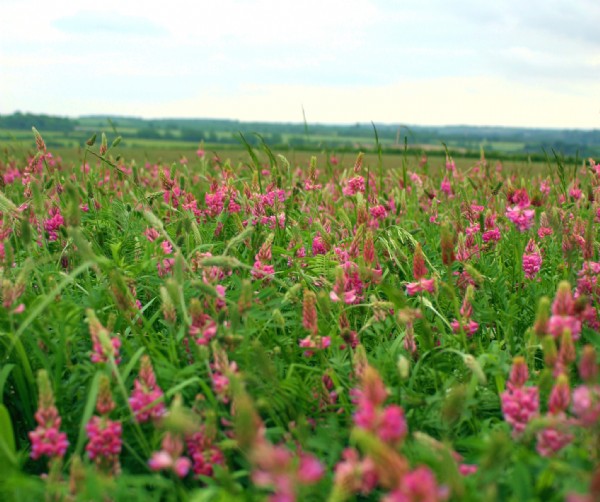

There is a record of sainfoin being imported into England from France in 1652. From this time onwards it became widely grown in certain areas mainly the Cotswolds, Salisbury plain and parts of East Anglia. It was grown for sheep, cattle and horses.
This was before the use of artificial fertilisers and there is little doubt that the crop is largely self sufficient, except that potash needs to be supplied, often from farmyard manure or wood or coal ash. Sainfoin was considered a vital cog in the farming rotation of those days and was known as a good preparation for ensuing crops. Some tenancy agreements stipulated that an acreage of sainfoin must be maintained. By 1800 in Oxfordshire it was grown on about 10% of the acreage in that county.
From around 1960 onwards the acreage declined rapidly as did the area of red clover and other leguminous crops. This was due to the advent of cheap nitrogen fertilisers and the extensive use of the newly developed strains of ryegrasses. Legumes were considered out of date. Intensive farming was in vogue, strongly promoted by the fertiliser manufacturers.
The last few years have seen a swing back into more traditional methods. Red clover is once more a very popular crop in the UK with longer duration varieties being available and the need to fix nitrogen on lower input systems. It would seem that the time is ripe for sainfoin also to make a comeback.
There are some 130 different Eurasian species of Onobrychis (from Greek "donkey fodder") but the main cultivated species is Onobrychis viciifolia Scop.
Some Sainfoin Facts
- The name sainfoin is from French meaning "healthy hay" also Latin Sanum Foenum. In England it was sometimes wrongly called Sainte Foine and thence "holy hay". It was known that animals fed on sainfoin were more healthy and put on weight more rapidly than on other forage
- Latin: (Onobrychis viciifolia)
- Common sainfoin: Duration 5 Years or more. English Origin
- Giant sainfoin: Duration 1-2 Years. Continental Origin
- Cultivars or bred strains which have been available to us so far include Nova (Canadion), Emyr (English), Perly (Swiss), a variety from China and some American bred varieties
Other sainfoins
Mountain Sainfoin - Onobrychis montana
Alpine Sainfoin - Hedysarum hedysaroides (Alpine meadows)
Italian Sainfoin - Hedysarum coronarium (Grown in Sicily)
Small Italian Sainfoin - Hedysarum glomeratum
Genetic resources 100 species - mostly tetraploids.
Distribution
We have research information on Sainfoin from Canada, USA, England, Switzerland, Russia, Poland, Bulgaria, Turkey, France, Romania and Armenia.
The fact that it has been grown in Canada and the former Soviet Union indicate that Sainfoin is very winter hardy as well as drought resistant.
by Robin Hill of Cotswold Seeds
Date Posted: 30th March 2017




